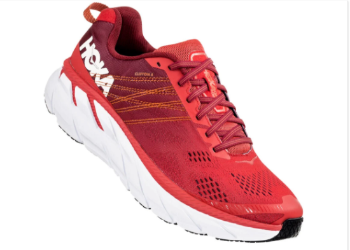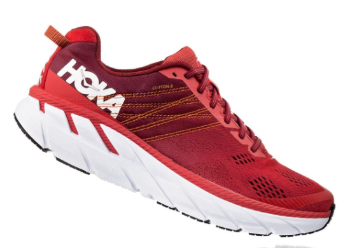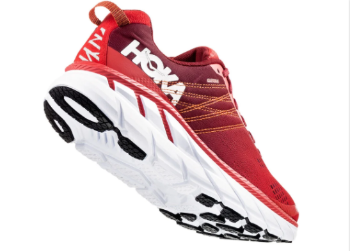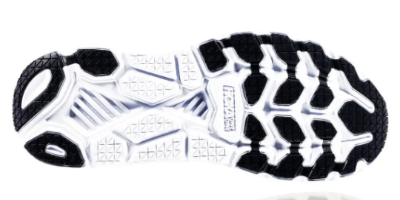Hoka Clifton 6 Review
Demonstrating the versatility and flexible attitude that made them a household name for dedicated runners, Hoka shoe company created a maximalist shoe at a time when everyone and their partner was going for a jog in barefoot shoes. The continued success of the Hoka One One Clifton, now in its 6th gen, shows that one size never fits all when it comes to body types and performance sports. The first Clifton appeared in 2014, and they have been tweaking and innovating, based on customer feedback, ever since.
Actually, in 2018, they re-released the Clifton 1. Runners everywhere celebrated. A reissue is kind of rare in the running shoe world. It is more like something Nike would do with an Air Jordan, Air Max, or Cortez sneaker. Running shoe technology changes fast–just try and find anyone rocking five finger sock-type shoes at your next 5K. The fact that there was enough demand for Hoka to justify re-releasing the original Clifton just shows the loyalty this upstart company inspires.
As much as we love all the Cliftons, though, this review is to help you decide if the newest release, the Hoka Clifton 6, is right for you. Read on to learn more.
Remarkably lightweight, but still a maximalist shoe with tons of support
Synthetic mesh upper lets feet breathe, cuts down on sweat and odor
The shoe is aesthetically pleasing; an old pair can function as a fashion piece year-round
Clifton 6 is an excellent choice for runners trying out maximalist shoes for the first time
Shoe comes in a spectrum of colors and patterns, including bright colors for high visibility
Shoe is supportive enough for the track, sidewalk, treadmill, and even for (short) trail runs
A shoe this supportive is not necessary for everyone; if it is (i.e. for pain relief) it will still take some getting used to
Shoe silhouette is unusual, HOKA logo is super prominent; you may prefer something more low key for your runs
Mesh will get cold in the winter unless you wear thick wool or Merino wool socks
The Rundown
None of their shoes are cheap unless you are lucky enough to find one used (happened to us at a thrift store!). The shoes are high enough quality that the treads will have life in them and the cushioning will be cushiony, at least enough to try before you buy a new pair, when you scout out a secondhand deal. Also, since they are forever upgrading their designs, you can go to their site or somewhere like Zappos and buy a new but slightly outdated pair for a discount. If you want the Hoka One One Clifton 6, though, and you need it new in the box, you can expect to spend more than a hundred dollars anywhere you look.
For that investment, you get a durable shoe that will completely shield your joints and bones from hard pavement impact or pebbles and other debris. Are you an urban runner, like some of your editors? Broken glass doesn't stand a chance against these outsoles, even somewhere like New York.
Now, another thing about the big city--if you live in one, you know space is at a premium. It is why we write so much about compact exercise equipment, like folding elliptical machines. It is hard to imagine if you live in the suburbs, but city closets can be so small that you have to think about how many shoes you can fit. And that brings us to the only real downside we found with the Hoka Clifton 6: it is "just" a running shoe, providing massive comfort and support for runners who need it. If you cross-train or lift at the gym, you will need a good cross-training sneaker and/or lifting shoe for heavy squats. You can wear the Clifton 6 on cardio or Nautilus style machines, sure, but they are not suited to exercises where you need your toes to connect and splay on the gym floor.
So, if space is super tight, and you need one pair of shoes to meet several needs, the Clifton 6 may not be the best choice.
They offer the Clifton 6 in regular and wide sizes. This is good news for runners with larger feet or those who like to spread their toes. The toe box is roomy; it, along with the ample cushioning, will strongly discourage conditions like plantar fasciitis. Pair these shoes with some breathable compression socks for women, and you will feel unstoppable.
Stack Versus Drop
Though, as we said, you can run almost anywhere in the Hoka Clifton 6, they are best suited to road runners. Distance running, on a road, may mean pounding a combination of concrete sidewalks, asphalt blacktop, and the odd patch of grass or vegetation. You also encounter obstacles like trash thrown out of cars. With this shoe, you are safe and protected from all of it, with less soreness and tightness on your next recovery day.
Materials/Comfort/Extra Features
They reinforced the mesh with embroidery, similar to Nike Flyknit or Reebok Flexweave fabric. This gives the shoe extra strength and flexibility to reduce tearing or fraying. The cohesion of the layers also helps lock down your midfoot, ensuring a solid heel strike every time during a run. It is refreshing to see Hoka, the understated geniuses, using a special synthetic fabric without resorting to ad copy hype or making it sound like they synthesized a new element to add to the periodic table. The historical truth is, Hoka almost singlehandedly kicked off the maximalist shoe trend with their flagship Hoka One One, introduced in 2010 and soon endorsed by a French endurance athlete named Nicolas Mermoud.
Critics compared that shoe to clown shoes or moon boots, because of the sole stack--but Hoka laughed all the way to the middle of the pack in American runner's favorite running shoe. 9% of runners called it their favorite shoe in 2017. That figure gets more impressive when you realize Nike, who has been around 3 decades or so longer than Hoka, only measured as the favorite for 12% of runners. (These figures are from a credible business analytics website called Statista).
The Final Word
While maximalist shoes are not for everyone, they could be for you if you are an overpronator, have a large body frame, suffer from chronic pain or inflammation, or just enjoy a padded ride and want to avoid soreness whenever possible. Those are all valid reasons to embrace thick, supportive running shoes. If you go with Hoka, you will be joining millions of satisfied runners with a durable product that will last you a long time and take you anywhere you want to go with your running practice.














